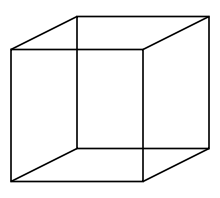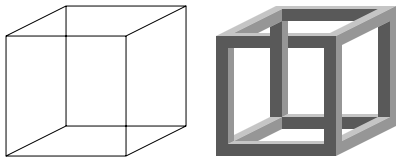Necker cube
The Necker cube is an optical illusion first published as a rhomboid in 1832 by Swiss crystallographer Louis Albert Necker.[1] It is a simple wire-frame drawing of a cube with no visual cues as to its orientation, so it can be interpreted to have either the lower-left or the upper-right square as its front side.



Ambiguity
The Necker cube is an ambiguous drawing.

The effect is interesting because each part of the picture is ambiguous by itself, yet the human visual system picks an interpretation of each part that makes the whole consistent. The Necker cube is sometimes used to test computer models of the human visual system to see whether they can arrive at consistent interpretations of the image the same way humans do.
Humans do not usually see an inconsistent interpretation of the cube. A cube whose edges cross in an inconsistent way is an example of an impossible object, specifically an impossible cube (compare Penrose triangle).
With the cube on the left, most people see the lower-left face as being in front most of the time. This is possibly because people view objects from above, with the top side visible, far more often than from below, with the bottom visible, so the brain "prefers" the interpretation that the cube is viewed from above.[2][3] Another reason behind this may be due to the brain's natural preference of viewing things from left to right,[4] therefore seeing the leftmost square as being in front.
There is evidence that by focusing on different parts of the figure, one can force a more stable perception of the cube. The intersection of the two faces that are parallel to the observer forms a rectangle, and the lines that converge on the square form a "y-junction" at the two diagonally opposite sides. If an observer focuses on the upper "y-junction" the lower left face will appear to be in front. The upper right face will appear to be in front if the eyes focus on the lower junction.[5] Blinking while being on the second perception will probably cause you to switch to the first one.

It is possible to cause the switch to occur by focusing on different parts of the cube. If one sees the first interpretation on the right it is possible to cause a switch to the second by focusing on the base of the cube until the switch occurs to the second interpretation. Similarly, if one is viewing the second interpretation, focusing on the left side of the cube may cause a switch to the first.
The Necker cube has shed light on the human visual system.[6] The phenomenon has served as evidence of the human brain being a neural network with two distinct equally possible interchangeable stable states.[7] Sidney Bradford, blind from the age of ten months but regaining his sight following an operation at age 52, did not perceive the ambiguity that normal-sighted observers do, but rather perceived only a flat image.[8][2]
During the 1970s, undergraduates in the Psychology Department of City University, London, were provided with assignments to measure their Introversion-Extroversion orientations by the time it took for them to switch between the Front and Back perceptions of the Necker Cube.
Apparent viewpoint
The orientation of the Necker cube can also be altered by shifting the observer's point of view. When seen from apparent above, one face tends to be seen closer; and in contrast, when seen from a subjective viewpoint that is below, a different face comes to the fore.[9]
References in popular culture
The Necker cube is discussed to such extent in Robert J. Sawyer's 1998 science fiction novel Factoring Humanity that "Necker" becomes a verb, meaning to impel one's brain to switch from one perspective or perception to another.[10]
The Necker cube is used to illustrate how vampires in Peter Watts' science fiction novels Blindsight (2006) and Echopraxia (2014) have superior pattern recognition skills. One of the pieces of evidence is that vampires can see both interpretations of the Necker Cube simultaneously which sets them apart from baseline humanity.[11]
See also
- Multistable perception
- Rhombille tiling
- Spinning Dancer
- Ambigram
References
- Necker 1832.
- Troje & McAdam 2010.
- Ward & Scholl 2015, p. 931.
- Khan & Crawford 2001.
- Einhäuser, Martin & König 2004.
- Ward & Scholl 2015.
- Marr 1982.
- Gregory 2004.
- Martelli, Kubovy & Claessens 1998.
- Sawyer 1998, pp. 233, 256, 299, et al..
- Watts 2006, pp. 42, 284.
Citations
- Einhäuser, W.; Martin, K.A.C.; König, P. (2004). "Are switches in perception of the Necker cube related to eye position?". European Journal of Neuroscience. 20 (10): 2811–2818. CiteSeerX 10.1.1.71.6358. doi:10.1111/j.1460-9568.2004.03722.x. PMID 15548224.CS1 maint: ref=harv (link)
- Gregory, R. (August 2004). "The Blind Leading the Sighted: An Eye-Opening Experience of the Wonders of Perception" (PDF). Nature. 430 (7002): 836. doi:10.1038/430836a. PMID 15318199.CS1 maint: ref=harv (link)
- Khan, Aarlenne; Crawford, J. Douglas (June 2001). "Ocular dominance reverses as a function of horizontal gaze angle". Vision Research. 41 (14): 1743–8. doi:10.1016/S0042-6989(01)00079-7. PMID 11369037.CS1 maint: ref=harv (link)
- Marr, D. (1982). Vision: A Computational Investigation into the Human Representation and Processing of Visual Information. W.H. Freeman. Reprint: The MIT Press. ISBN 978-0-7167-1284-8.CS1 maint: ref=harv (link)
- Martelli, M.L.; Kubovy, M.; Claessens, P. (1998). "Instability of the Necker cube: influence of orientation and configuration". Perception. 27 (ECVP Abstract Supplement). 90a.CS1 maint: ref=harv (link)
- Necker, L.A. (1832). "Observations on some remarkable optical phaenomena seen in Switzerland; and on an optical phaenomenon which occurs on viewing a figure of a crystal or geometrical solid". London and Edinburgh Philosophical Magazine and Journal of Science. 1 (5): 329–337. doi:10.1080/14786443208647909.CS1 maint: ref=harv (link)
- Sawyer, Robert J. (1998). Factoring Humanity. New York: Tor. ISBN 978-0-312-86458-3.CS1 maint: ref=harv (link)
- Troje, Nikolaus F.; McAdam, Matthew (2010). "The viewing-from-above bias and the silhouette illusion". I-Perception. 1 (3): 143–148. doi:10.1068/i0408. PMC 3485768. PMID 23145219.CS1 maint: ref=harv (link)
- Ward, Emily J.; Scholl, Brian J. (2015). "Stochastic or Systematic? Seemingly Random Perceptual Switching in Bistable Events Triggered by Transient Unconscious Cues" (PDF). Journal of Experimental Psychology: Human Perception and Performance. 41 (4): 929–939. doi:10.1037/a0038709. PMID 25915074.CS1 maint: ref=harv (link)
- Watts, Peter (2006). Blindsight. Tor. ISBN 978-0-7653-1218-1.CS1 maint: ref=harv (link)
External links
| Wikimedia Commons has media related to Necker cubes. |